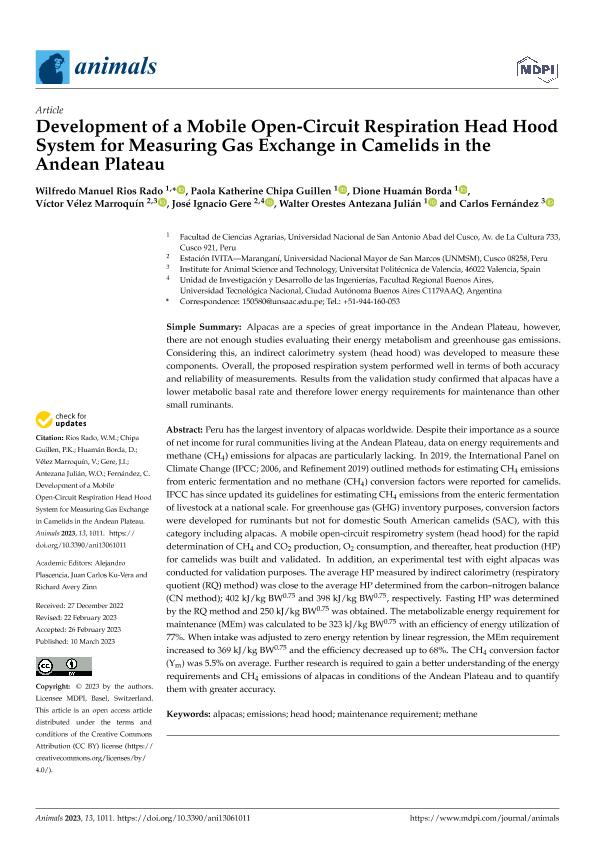Artículo
Development of a Mobile Open-Circuit Respiration Head Hood System for Measuring Gas Exchange in Camelids in the Andean Plateau
Rios Rado, Wilfredo Manuel; Chipa Guillen, Paola Katherine; Huamán Borda, Dione; Vélez Marroquín, Víctor; Gere, José Ignacio ; Orestes Antezana Julián, Walter; Fernández, Carlos
; Orestes Antezana Julián, Walter; Fernández, Carlos
 ; Orestes Antezana Julián, Walter; Fernández, Carlos
; Orestes Antezana Julián, Walter; Fernández, Carlos
Fecha de publicación:
03/2023
Editorial:
Multidisciplinary Digital Publishing Institute
Revista:
Animals
ISSN:
2076-2615
Idioma:
Inglés
Tipo de recurso:
Artículo publicado
Clasificación temática:
Resumen
Peru has the largest inventory of alpacas worldwide. Despite their importance as a source of net income for rural communities living at the Andean Plateau, data on energy requirements and methane (CH4) emissions for alpacas are particularly lacking. In 2019, the International Panel on Climate Change (IPCC; 2006, and Refinement 2019) outlined methods for estimating CH4 emissions from enteric fermentation and no methane (CH4) conversion factors were reported for camelids. IPCC has since updated its guidelines for estimating CH4 emissions from the enteric fermentation of livestock at a national scale. For greenhouse gas (GHG) inventory purposes, conversion factors were developed for ruminants but not for domestic South American camelids (SAC), with this category including alpacas. A mobile open-circuit respirometry system (head hood) for the rapid determination of CH4 and CO2 production, O2 consumption, and thereafter, heat production (HP) for camelids was built and validated. In addition, an experimental test with eight alpacas was conducted for validation purposes. The average HP measured by indirect calorimetry (respiratory quotient (RQ) method) was close to the average HP determined from the carbon–nitrogen balance (CN method); 402 kJ/kg BW0.75 and 398 kJ/kg BW0.75, respectively. Fasting HP was determined by the RQ method and 250 kJ/kg BW0.75 was obtained. The metabolizable energy requirement for maintenance (MEm) was calculated to be 323 kJ/kg BW0.75 with an efficiency of energy utilization of 77%. When intake was adjusted to zero energy retention by linear regression, the MEm requirement increased to 369 kJ/kg BW0.75 and the efficiency decreased up to 68%. The CH4 conversion factor (Ym) was 5.5% on average. Further research is required to gain a better understanding of the energy requirements and CH4 emissions of alpacas in conditions of the Andean Plateau and to quantify them with greater accuracy.
Palabras clave:
ALPACAS
,
EMISSIONS
,
HEAD HOOD
,
MAINTENANCE REQUIREMENT
,
METHANE
Archivos asociados
Licencia
Identificadores
Colecciones
Articulos(SEDE CENTRAL)
Articulos de SEDE CENTRAL
Articulos de SEDE CENTRAL
Citación
Rios Rado, Wilfredo Manuel; Chipa Guillen, Paola Katherine; Huamán Borda, Dione; Vélez Marroquín, Víctor; Gere, José Ignacio; et al.; Development of a Mobile Open-Circuit Respiration Head Hood System for Measuring Gas Exchange in Camelids in the Andean Plateau; Multidisciplinary Digital Publishing Institute; Animals; 13; 6; 3-2023; 1-14
Compartir
Altmétricas



